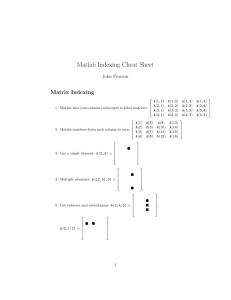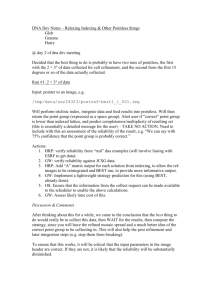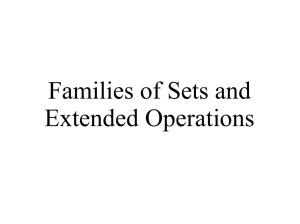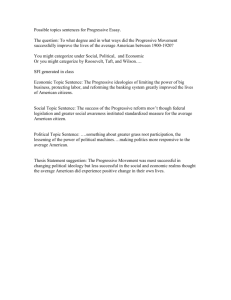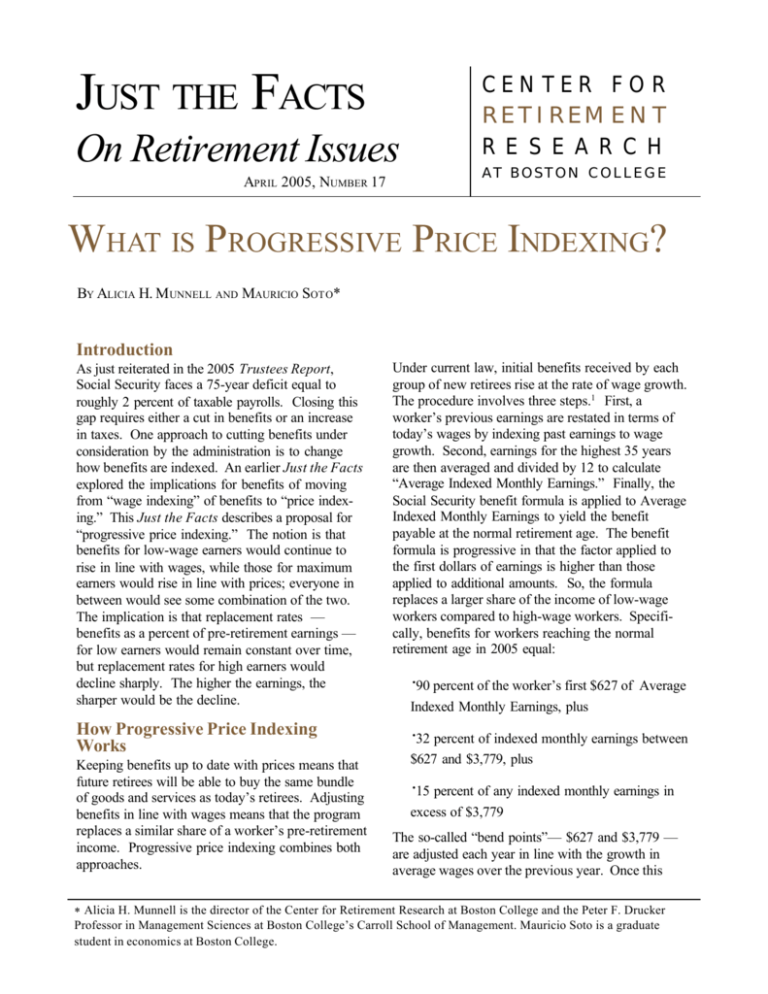
JUST THE FACTS
On Retirement Issues
APRIL 2005, NUMBER 17
CENTER FOR
RETIREM E N T
R E S E A R C H
AT BOSTON C O L L E G E
WHAT IS PROGRESSIVE PRICE INDEXING?
BY ALICIA H. MUNNELL AND MAURICIO SOT O*
Introduction
As just reiterated in the 2005 Trustees Report,
Social Security faces a 75-year deficit equal to
roughly 2 percent of taxable payrolls. Closing this
gap requires either a cut in benefits or an increase
in taxes. One approach to cutting benefits under
consideration by the administration is to change
how benefits are indexed. An earlier Just the Facts
explored the implications for benefits of moving
from “wage indexing” of benefits to “price indexing.” This Just the Facts describes a proposal for
“progressive price indexing.” The notion is that
benefits for low-wage earners would continue to
rise in line with wages, while those for maximum
earners would rise in line with prices; everyone in
between would see some combination of the two.
The implication is that replacement rates —
benefits as a percent of pre-retirement earnings —
for low earners would remain constant over time,
but replacement rates for high earners would
decline sharply. The higher the earnings, the
sharper would be the decline.
How Progressive Price Indexing
Works
Keeping benefits up to date with prices means that
future retirees will be able to buy the same bundle
of goods and services as today’s retirees. Adjusting
benefits in line with wages means that the program
replaces a similar share of a worker’s pre-retirement
income. Progressive price indexing combines both
approaches.
Under current law, initial benefits received by each
group of new retirees rise at the rate of wage growth.
The procedure involves three steps.1 First, a
worker’s previous earnings are restated in terms of
today’s wages by indexing past earnings to wage
growth. Second, earnings for the highest 35 years
are then averaged and divided by 12 to calculate
“Average Indexed Monthly Earnings.” Finally, the
Social Security benefit formula is applied to Average
Indexed Monthly Earnings to yield the benefit
payable at the normal retirement age. The benefit
formula is progressive in that the factor applied to
the first dollars of earnings is higher than those
applied to additional amounts. So, the formula
replaces a larger share of the income of low-wage
workers compared to high-wage workers. Specifically, benefits for workers reaching the normal
retirement age in 2005 equal:
·90 percent of the worker’s first $627 of Average
Indexed Monthly Earnings, plus
·32 percent of indexed monthly earnings between
$627 and $3,779, plus
·15 percent of any indexed monthly earnings in
excess of $3,779
The so-called “bend points”— $627 and $3,779 —
are adjusted each year in line with the growth in
average wages over the previous year. Once this
∗ Alicia H. Munnell is the director of the Center for Retirement Research at Boston College and the Peter F. Drucker
Professor in Management Sciences at Boston College’s Carroll School of Management. Mauricio Soto is a graduate
student in economics at Boston College.
initial benefit is awarded, it is adjusted each year in
line with the Consumer Price Index so that beneficiaries can maintain their purchasing power in
retirement.
indexing, and those that emerge from progressive
price indexing. (Note that replacement rates are
already scheduled to decline under current law as a
result of the increase in the normal retirement age
from 65 to 67.) As described, low earning individuals get the same replacement rates as they
would under current law, and maximum earners get
the same replacement rates as they would under
price indexing. Those in between do better than
they would under price indexing, but experience
substantial cuts relative to current law.
Under progressive price indexing, the bottom 30
percent of workers — those that make less than
about $20,000 today — would have their benefits
calculated under the current formula. Those workers who earn the taxable maximum — currently
$90,000 — over their lifetime would have their
benefits calculated using price indexing. 2 Those
earning between $20,000 and $90,000 would get a
benefit somewhere between the benefit provided
under current law and that provided under price
indexing.
Figure 1 shows the percent reductions relative to
current law for the progressive price indexing
proposal. These reductions are for a medium earner
(one who makes $36,600 today) retiring at age 65
in various years.
Table 1 shows the replacement rates scheduled
under current law, those that emerge from price
Mechanics of Progressive Price Indexing
Reading the technical detail in this Box will make most people miserable! Under the progressive indexing proposal,
Average Indexed Monthly Earnings (AIME) would continue to be calculated as under current law. But the procedure
would introduce a new “bend point” to isolate low-income workers from benefit changes. If progressive indexation were
to start immediately, the benefit of workers reaching normal retirement age in 2005 would equal:
Old Formula
•
•
•
90 percent of the worker’s first $627 of AIME, plus
32 percent of AIME between $627 and $3,779, plus
15 percent of any AIME in excess of $3,779.
New Formula
•
•
•
•
90 percent of the worker’s first $627 of AIME, plus
32 percent of AIME between $627 and $1,528, plus
32 percent of AIME between $1,528 and $3,779, plus
15 percent of any AIME in excess of $3,779.
The $1,528 “bend point” was selected so that 30 percent of workers have AIMEs below that amount. (The approach is
flexible in that the 30 percent threshold could be made higher or lower.) Progressive indexing works by reducing the
factors in the benefit formula above the newly introduced “bend point” — that is, the 32 percent between $1,528 and
$3,779 and the 15 percent above $3,779. This is done by calculating the amount necessary to keep the benefit of a maximum earner constant in real terms, and backing out the factors that would produce that amount. The two factors are
required to be reduced by the same proportion. Note that under progressive indexing, as under current law, the bend points
— $627, $1,528, and $3,779 — would be adjusted each year in line with the growth in average wages.
The result is a hybrid indexing between the current method of indexing
and price indexing. Initial benefits received by each group of low-income
retirees still rise at the rate of wage growth, while the initial benefits of
those with earnings at the maximum will only increase with prices. For
those in between, initial benefits will increase slower than the rate of
growth of wages, but faster than price increases.
2
Year
Factor
1
Factor
2
Factor
3
Factor
4
2005
.90
.32
.32
.15
2035
.90
.32
.20
.09
2075
.90
.32
.05
.02
Implications for the Benefit Structure
FIGURE 1. PROGRESSIVE INDEXING REDUCES BENEFITS BY
Progressive price indexing would dramatically
INCREASING AMOUNTS OVER TIME
change the benefit structure over time. Today, high
earners contribute more in payroll taxes and receive a Percentage Reduction from Current Law for Medium Earner
larger dollar benefit than medium earners. As shown
in Figure 2 (see page 4), by 2100 virtually all Social
Security beneficiaries with earnings above the
2055
2075
2005
2015
2035
medium would receive the same dollar benefit
0%
regardless of how much they contributed to the
system. Thus, if progressive price indexing were to
continue beyond the 75-year period, Social Security
would eventually provide a flat benefit rather than an
-10%
earnings related benefit for much of the population. 3
Implications for Social Security
Solvency
-20%
Progressive price indexing would reduce future
benefits enough to eliminate roughly three quarters of
the 75-year shortfall. Pure price indexing would
more than eliminate the entire 75-year deficit. The
-30%
remaining shortfall under progressive price indexing
thus would require either some new revenues or
further benefit cuts during the 75-year period.
Source: Authors’ calculations.
TABLE 1. SHIFT FROM WAGE TO P ROGRESSIVE P RICE INDEXING CUTS R EPLACEMENT RATES FOR MO S T WORKERS BUT
P ROTECTS LOW EARNERS
Percentage of Pre-Retirement Earnings Replaced by Social Security Benefits
Year
Type of Indexing
Earnings
Low
($16,470)
Medium
($36,600)
High
($58,560)
Maximum
($90,000)
2005
Current Law
57
42
35
30
2015
Current Law
Progressive Indexing
Price Indexing
53
53
50
39
38
37
32
31
31
26
25
25
2035
Current Law
Progressive Indexing
Price Indexing
49
49
38
36
32
28
30
24
23
24
19
19
2055
Current Law
Progressive Indexing
Price Indexing
49
49
31
36
29
23
30
21
19
24
15
15
2075
Current Law
Progressive Indexing
Price Indexing
49
49
25
36
26
18
30
18
15
24
12
12
Source: Authors’ calculations.
Note: The reduction in the replacement rate is scheduled to drop under the current system between 2005 and
2025 due to the increase in the “full benefits” retirement age from 65 to 67. Progressive and price indexation are
assumed to start in 2012.
3
FIGURE 2. PROGRESSIVE INDEXING FLATTENS BENEFITS
Benefits as Percent of Medium Earner Benefit
160%
2005
140%
2045
120%
2075
100%
2100
80%
Medium
High
Maximum
Source: Authors’ calculations based on presentation in
Furman (2005).
4
Conclusion
Progressive price indexing has the advantage of
protecting the benefits of low earning workers.
These workers would be assured of receiving the
same amount relative to previous earnings as
they do today. The cuts under progressive price
indexing come increasingly from those with
higher earnings. Ultimately, high earners will
receive the same dollar benefit as those making
much less. The policy question is whether it is
possible to cut the benefits of higher wage
workers so drastically and still retain their
support for the program. For this reason, proponents suggest combining progressive price
indexing with diverting part of the current
payroll tax to voluntary personal accounts as a
“sweetener.” To the extent that higher income
individuals can earn more than a real return of 3
percent — the rate used to offset traditional
benefits under President Bush’s personal account
proposal — they will be able to compensate for
some of the reduction in their benefit. But some
recent studies suggest a 3 percent real return may
be a high hurdle.4
Endnotes
References
1 For a detailed explanation of how to calculate
Social Security benefits, see Social Security
Administration (2004).
Andrews, Edumund L. “Social Security, Growth
and Stock Returns.” New York Times (March 31,
2005).
2 As described in the earlier Just the Facts, the
mechanics of price indexing are as follows:
Average Indexed Monthly Earnings would
continue to be calculated as under current law.
But the benefit formula would be changed. Each
year, the factors in the benefit formula — that is,
the 90 percent, the 32 percent, and the 15 percent
— would be adjusted to offset the growth of real
wages. This is done by multiplying each factor
by the ratio of the change in the consumer price
index over the previous year to the change in
nominal wages. Since wages typically increase
faster than prices, this number will generally be
less than one. For example, if in the year after
price indexing was enacted the Consumer Price
Index increased by 3 percent and wages increased by 4 percent, the ratio would be 1.03
divided by 1.04, or 0.99 percent. The factors
would then be multiplied by .99. And the effect
on benefits would be cumulative over time.
3 Benefits become flat once the two upper factors
used in the calculation of the primary insurance
amount reach zero. Since the factors would
likely not go below zero, at this point the flat
benefit would begin increasing again at the rate
of wage growth.
4 Shiller (2005); Andrews (2005); Whitehouse
(2005); and Goldman Sachs (2005).
Furman, Jason. 2005. “An Analysis of Using
“Progressive Price Indexing” to Set Social Security Benefits.” Center for Budget and Policy
Priorities (March 21).
Goldman Sachs. 2005. “Social Security Reform:
Are Personal Savings Accounts Attractive?” US
Daily Financial Market Comment. (February 23,
2005).
Shiller, Robert J. 2005. “The Life-Cycle Personal
Accounts for Social Security: An Evaluation.”
unpublished mimeo (March).
Social Security Administration. 2004. Annual
Statistical Supplement, 2003. Office of Policy
(http://www.ssa.gov/policy/docs/statcomps/
supplement/).
Social Security Administration. 2005. “Estimated
Financial Effects of a Comprehensive Social
Security Reform Proposal Including Progressive
Price Indexing.” Memorandum from Stephen C.
Goss to Bob Pozen (February 10).
Whitehouse, Mark. 2005. “Social Security Overhaul Plan Leans on a Bullish Market.” Wall Street
Journal. (February 28).
5
The Center for Retirement Research thanks its research partners for support of this project:
CitiStreet, Prudential Financial, AMVESCAP, New York Life Investment Management,
AARP, TIAA-CREF Institute, AXA Financial, and Standard & Poor’s.
© 2005, by Trustees of Boston College, Center for Retirement Research. All rights reserved. The research reported herein was
supported by the Center’s Corporate Partnership Program. The opinions and conclusions expressed are solely those of the
authors and should not be construed as representing the opinions or policy of the Center for Retirement Research at Boston College.
CENTER
FOR
RETIREMENT RESEARCH
AT
BOSTON COLLEGE
Fulton Hall 550, 140 Commonwealth Avenue, Chestnut Hill, MA 02467-3803
phone 617.552.1762 fax 617.552.0191 crr@bc.edu www.bc.edu/crr

